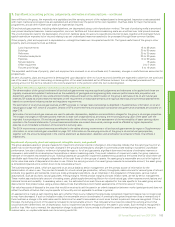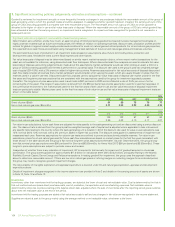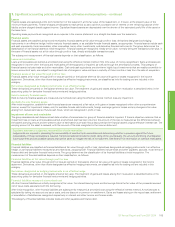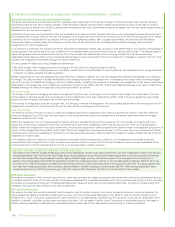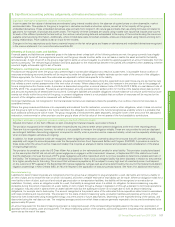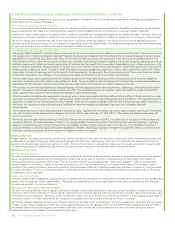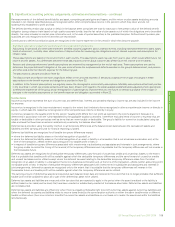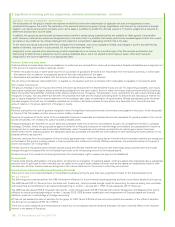BP 2014 Annual Report Download - page 117
Download and view the complete annual report
Please find page 117 of the 2014 BP annual report below. You can navigate through the pages in the report by either clicking on the pages listed below, or by using the keyword search tool below to find specific information within the annual report.
2. Significant event – Gulf of Mexico oil spill – continued
addition, BP faces claims under the Oil Pollution Act of 1990 (OPA 90) for natural resource damages. These damages include, among other things, the
reasonable costs of assessing the injury to natural resources. During 2011, BP entered into a framework agreement with natural resource trustees for
the United States and five Gulf-coast states, providing for up to $1 billion to be spent on early restoration projects to address natural resource injuries
resulting from the oil spill, to be funded from the $20-billion trust fund. In 2012, work began on the initial set of early restoration projects identified
under this framework and during 2014, Phase 3 of the early restoration projects was formally agreed, comprising $627 million of approved project
spend (of which $563 million has been paid). At 31 December 2014, the remaining amount provided for natural resource damage assessment costs
and early restoration projects was $798 million. Until the size, location and duration of the impact is assessed, it is not possible to estimate reliably
either the amounts or timing of the remaining natural resource damages claims other than the assessment and early restoration costs noted above,
therefore no additional amounts have been provided for these items and they are disclosed as a contingent liability.
Litigation and claims
The litigation and claims provision includes amounts that can be estimated reliably for the future cost of settling claims by individuals and businesses
for damage to real or personal property, lost profits or impairment of earning capacity and loss of subsistence use of natural resources (‘Individual and
Business Claims’), and claims by state and local government entities for removal costs, damage to real or personal property, loss of government
revenue and increased public services costs, under OPA 90 and other legislation (‘State and Local Claims’), except as described under Contingent
liabilities below. Claims administration costs and legal costs, including legal costs under indemnification agreements, have also been provided for.
The timing of payment of litigation and claims provisions classified as non-current is dependent upon ongoing legal activity and is therefore uncertain.
BP has provided for its best estimate of the cost associated with the PSC settlement agreements with the exception of the cost of business economic
loss claims, which are provided for where an eligibility notice had been issued before the end of the month following the balance sheet date and is not
subject to appeal by BP within the claims facility. As disclosed in BP Annual Report and Form 20-F 2013, as part of its monitoring of payments made by
the DHCSSP, BP identified multiple business economic loss claim determinations that appeared to result from an interpretation of the Economic and
Property Damages Settlement Agreement (EPD Settlement Agreement) by the claims administrator that BP believes was incorrect.
During 2014, there were various rulings on matters relating to the interpretation of the EPD Settlement Agreement, in particular on the issue of
matching revenue and expenses as well as causation requirements of the EPD Settlement Agreement.
In March 2014, the US Court of Appeals for the Fifth Circuit (the Fifth Circuit) affirmed the district court’s ruling that the EPD Settlement Agreement
contained no causation requirement beyond the revenue and related tests set out in an exhibit to that agreement. In March 2014, BP filed a petition
that all the active judges of the Fifth Circuit review the decision; in May 2014 this was denied. The district court dissolved the injunction that had halted
the processing and payment of business economic loss claims and instructed the claims administrator to resume the processing and payment of
claims. BP sought review by the US Supreme Court (Supreme Court) of the Fifth Circuit’s decisions relating to compensation of claims for losses with
no apparent connection to the Deepwater Horizon spill. In December 2014, the Supreme Court declined to review BP’s petition. As a result, the final
deadline for filing claims in the Economic and Property Damages Settlement is 8 June 2015.
Management believes that no reliable estimate can currently be made of any business economic loss claims (i) not yet received; (ii) received, but not yet
processed; or (iii) processed, but not yet paid, except where an eligibility notice had been issued before the end of the month following the balance sheet
date and is not subject to appeal by BP within the claims facility. The inability to estimate reliably such claims is due to uncertainty regarding both the
volume of such claims and the average value per claim.
In respect of uncertainty regarding the volume of claims, in December 2014, the Supreme Court declined to hear BP’s appeal of the district court ruling
that the EPD Settlement Agreement contained no causation requirement beyond the revenue and related tests set forth in that agreement. This
resolution, however, does not reduce uncertainty in the short term regarding the volume of claims, since it is possible that additional claims will be
made. In addition, a claims submission deadline of 8 June 2015 has now been set, which may lead to an increase in the rate of claims received until
the deadline, compounding management’s inability to estimate the total volume of claims that will be made.
In respect of uncertainty regarding the average value per claim, a small proportion of the filed claims have been determined under the revised policy for
the matching of revenue and expenses for business economic loss claims (introduced in May 2014) and disputes, disagreements, and uncertainties
regarding the proper application of the revised policy to particular claims and categories of claims continue to arise as the claims administrator has
begun applying the revised policy. Furthermore, there have been no, or only a small number of, claim determinations made under some of the
specialized frameworks that have been put in place for particular industries and so determinations to date may not be representative of the total
population of claims. In addition, due to a data secrecy order, detailed data about claims that have not yet been determined is not currently available to
BP and so it is not possible to review claim demographics or identify potential populations for each category of claim.
There is therefore very little data to build up a track record of claims determinations under the policies and protocols that are now being applied
following resolution of the matching and causation issues. We therefore cannot estimate future trends of the number and proportion of claims that will
be determined to be eligible, nor can we estimate the value of such claims. A provision for such business economic loss claims will be established
when these uncertainties are resolved and a reliable estimate can be made of the liability.
The current estimate for the total cost of those elements of the PSC settlement that BP considers can be reliably estimated is $9.9 billion. The
DHCSSP has issued eligibility notices, most of which are disputed by BP, in respect of business economic loss claims of approximately $400 million
which have not been provided for. The majority of these claims are being re-assessed using the new matching policy. Furthermore, a significant
number of business economic loss claims have been received but have not yet been processed, and further claims are likely to be received. The total
cost of the PSC settlement is likely to be significantly higher than the amount recognized to date of $9.9 billion because the current estimate does not
reflect business economic loss claims not yet received, or received but not yet processed, or processed but not yet paid, except where an eligibility
notice had been issued before the end of the month following the balance sheet date and is not subject to appeal by BP within the claims facility.
The provision recognized for litigation and claims includes an estimate for State and Local Claims. Although the provision recognized is BP’s current
reliable best estimate of the amount required to settle these obligations, significant uncertainty exists in relation to the outcome of any litigation
proceedings and the amount of claims that will become payable by BP.
Significant uncertainties exist in relation to the amount of claims that are to be paid and will become payable, including claims payable under the
DHCSSP and State and Local Claims. There is significant uncertainty in relation to the amounts that ultimately will be paid in relation to current claims,
and the number, type and amounts payable for claims not yet reported as described above and in Legal proceedings on page 228 and the outcomes of
any further litigation including in relation to potential opt-outs from the PSC settlement or otherwise. There is also uncertainty as to the cost of
administering the claims process under the DHCSSP and in relation to future legal costs.
See Legal proceedings on page 228 and Contingent liabilities below for further details.
Financial statements
BP Annual Report and Form 20-F 2014 113


